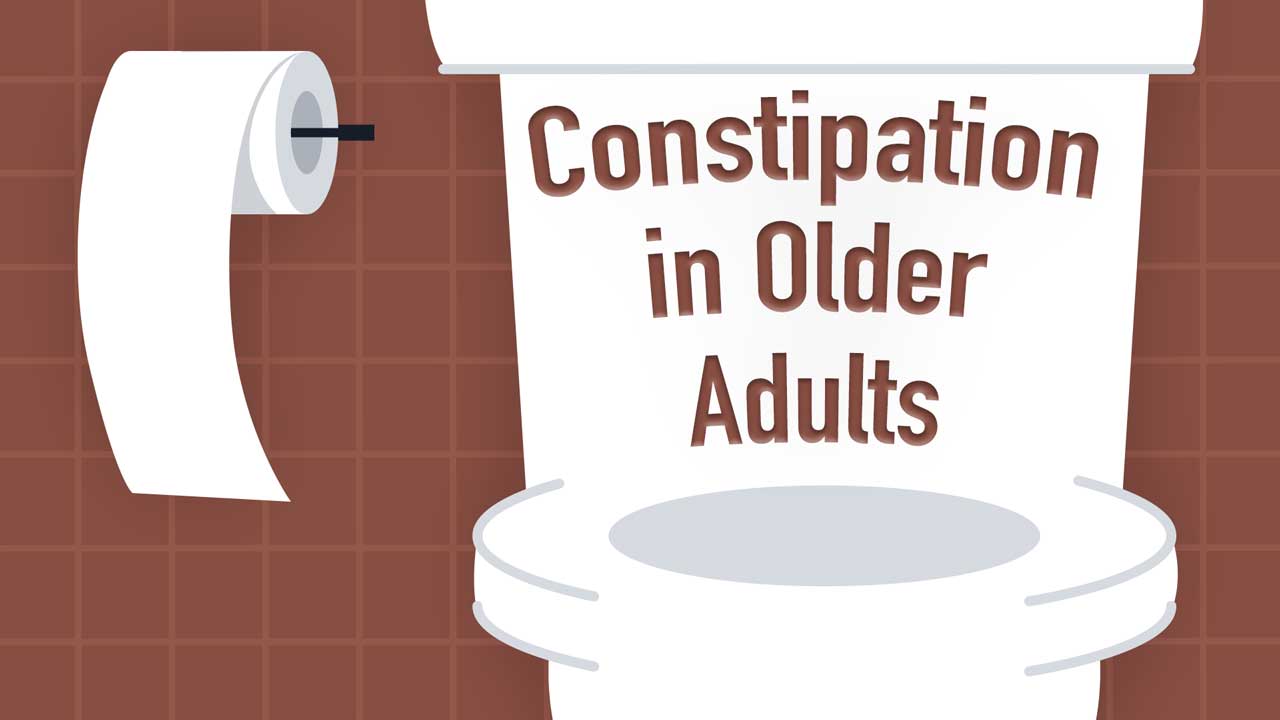Constipation is a medical issue to be taken seriously, particularly when present in the older adult. Older adults are considered to be a primary at-risk group for chronic constipation. In fact, it’s estimated that older adults are five times more likely to develop constipated-related problems than younger adults (Mandal 2023).
What is Constipation?
Constipation is often defined as having fewer than three bowel movements a week (Better Health Channel 2024).
It also encompasses the passing of hard, dry bowel motions or straining to defecate (Better Health Channel 2024; AMBOSS 2023).
Constipation can usually be prevented and treated by maintaining a high-fibre diet, increasing water intake and exercising regularly (Better Health Channel 2024).

Why Does Constipation Occur?
The process of digestion is as follows: when food is consumed, it breaks down in the stomach and passes through the intestines. The walls of the intestines then absorb nutrients from the food. The remaining waste is then passed through the colon and rectum (Chavoustie & Kahn 2024).
However, if the waste moves through the colon too slowly, too much water is absorbed from it. Consequently, the resulting stool is dry, hard and difficult to pass (AMBOSS 2023; Mayo Clinic 2023).
Causes of Constipation in Older Adults
There are many reasons why constipation affects older adults. Examples include:
- Side effects of certain medicines, including opiates, antidepressants, anticonvulsants and antihistamines
- Comorbidities such as strictures, hypothyroidism, tumours or Parkinson’s disease
- Prolonged bed rest, perhaps during illness, resulting in a decrease in movement
- Lack of interest in eating (frequently seen in single or widowed older people), resulting in the consumption of low-effort food that is typically low in fibre
- Slowing or weakening of the digestive system as a result of ageing and/or frailty
- Poor diet or lack of adequate fluids in diet
- Lack of exercise
- Urinary/stress incontinence, which is common in older adults
- Absence of teeth, which can make it difficult to eat regular meals.
(Chow 2021; Mandal 2023)
Constipation can also be the result of more serious illnesses and events, including tumours and systemic conditions (Better Health Channel 2024).
Common Types of Constipation in Older Adults
Constipation can be either primary - meaning there is no underlying medical cause - or secondary - meaning there is an underlying cause (AMBOSS 2023).
Types of primary constipation include:
- Normal transit constipation: Although a stool passes through the colon at a regular pace, patients perceive difficulty in passing bowel motions. This is often associated with IBS.
- Slow-transit constipation: Predominantly affects females. Bowel movements are infrequent, limited in their urgency or involve straining.
- Pelvic floor dysfunction: Difficulty in coordinating pelvic floor muscles or muscles around the anus during defecation. This often creates a feeling of an incomplete bowel motion.
(Mandal 2023)
Symptoms of Constipation
Symptoms of constipation include:
- Needing to open the bowels less frequently
- Hard, dry stools that might be hard to pass
- Painfully straining to pass a bowel motion
- Feeling as though there is a blockage preventing a bowel movement
- Having to sit on the toilet for long periods of time
- A sensation that the bowel has not fully emptied after a motion
- Having a bloated abdomen
- Abdominal cramps.
(Better Health Channel 2024; Mayo Clinic 2023)
Risk Factors for Constipation
Being older than 65 is a major risk factor for chronic constipation. Other risk factors include:
- Being female
- Being pregnant
- Being ill
- Dehydration
- Insufficient fibre intake
- Lack of physical activity
- Mental health issues such as depression or having an eating disorder
- Taking regular medication for which constipation is a side effect.
(Djordjevic 2022; Better Health Channel 2024)
Potential Complications of Constipation
- Haemorrhoids: Swollen or damaged blood vessels in the anus
- Anal fissure: Torn skin in the anus, which can be caused by a hard or large stool
- Faecal impaction: Faecal matter in the lower bowel that cannot be passed
- Rectal prolapse: A section of the intestine protruding from the anus
- Faecal incontinence: The inability to control bowel movements
- Urinary incontinence: Constant straining can weaken pelvic floor muscles.
(Mayo Clinic 2023; Better Health Channel 2024)
Diagnosing Constipation
Diagnosis can involve a detailed medical history; a physical examination; questions relating to diet, exercise and lifestyle habits; a colonoscopy; or a combination of these (Mandal 2023; Better Health Channel 2024).
From this examination, the cause of the constipation can be identified (Mandal 2023).
Treating Constipation
Foods to Encourage:
- Soluble fibres: legumes, fruits, nuts, seeds and vegetables
- Insoluble fibres: wheat bran, wholegrain bread and cereals.
(Better Health Channel 2024; Mayo Clinic 2023)

Foods to Limit:
- Processed foods
- Dairy
- Refined grains (such as white rice)
- Red meat.
(Mayo Clinic 2023; Better Health Channel 2024; Chow 2021)
Drinking adequate amounts of water is a known strategy for preventing and aiding constipation. Water softens stools and stimulates the bowel (Chow 2021).
If a person’s diet is lacking in fibre and they are reluctant to eat certain foods, consider advising the intake of a fibre supplement (Better Health Channel 2024).
Laxatives
Laxatives are a treatment option for constipation if diet and lifestyle modifications do not provide a solution. There are two primary types of laxatives: osmotic laxatives and bulk forming laxatives (Better Health Channel 2024).
Exercise
Regular exercise is known to aid and regulate digestion. The minimum amount of exercise recommended is 30 minutes per day. In the case of an older person and/or where mobility issues are apparent, activity should be encouraged. Every small bit of exercise makes a difference (Better Health Channel 2024).
Stress Management
It’s been shown that depression and mood disorders can trigger constipation. Yoga, meditation or other relaxation techniques may aid this (MedicineNet 2021).
Creating a Routine
Try to establish a regular bathroom time in which the older adult tries to empty their bowels each day. In addition to this routine, they should be encouraged to go as soon as they feel the urge (Chow 2021).
Preventing Constipation
Encourage patients to:
- Maintain a high-fibre diet
- Avoid processed foods
- Drink plenty of water
- Exercise regularly
- Manage stress
- Maintain a regular schedule for bowel evacuation
- Avoid ignoring the urge to pass stools.
(Mayo Clinic 2023; Better Health Channel 2024)

Test Your Knowledge
Question 1 of 3
What is a common symptom of constipation?
Topics
Further your knowledge
References
- AMBOSS 2023, Constipation, AMBOSS, viewed 8 October 2024, https://www.amboss.com/us/knowledge/Constipation/
- Better Health Channel 2024, Constipation, Victoria State Government, viewed 8 October 2024, https://www.betterhealth.vic.gov.au/health/conditionsandtreatments/constipation
- Chow, C 2021, ‘Constipation in Seniors: 6 Effective Home Remedies’, DailyCaring, viewed 8 October 2024, https://dailycaring.com/constipation-in-seniors-6-effective-home-remedies/
- Djordjevic, N 2022, ‘Causes & Management of Constipation in Elderly People’, MedAlertHelp Blog, 9 January, viewed 8 October 2024, https://medalerthelp.org/blog/constipation-in-elderly/
- Chavoustie, CT & Kahn, A 2024, ‘What is Fecal Impaction (Impacted Bowel) and How Is It Treated?’, Healthline, 19 January, viewed 8 October 2024, https://www.healthline.com/health/fecal-impaction
- Mandal, A 2023, ‘Constipation in the Elderly’, News-Medical.Net, 23 January, viewed 8 October 2024, https://www.news-medical.net/health/Constipation-in-the-Elderly.aspx
- Mayo Clinic 2023, Constipation, Mayo Clinic, viewed 8 October 2024, https://www.mayoclinic.org/diseases-conditions/constipation/symptoms-causes/syc-20354253
- MedicineNet 2021, Digestive Disorders: 23 Constipation Myths and Facts, MedicineNet, viewed 8 October 2024, https://www.medicinenet.com/constipation_myths_facts_pictures_slideshow/article.htm
 New
New 

